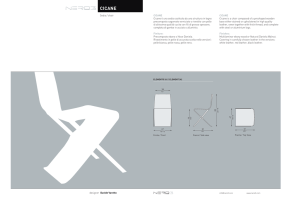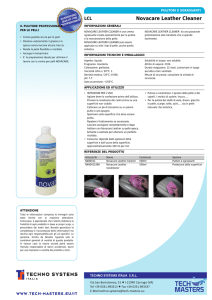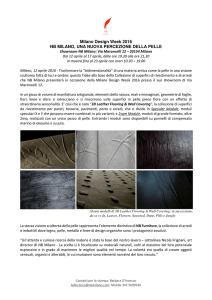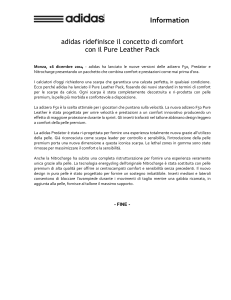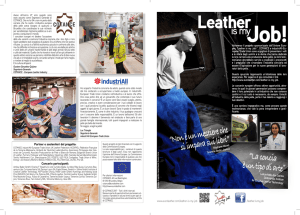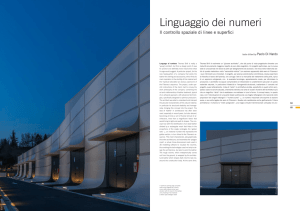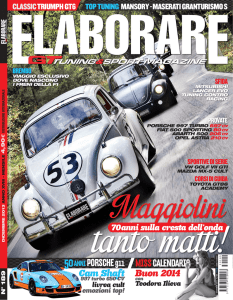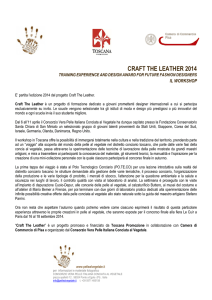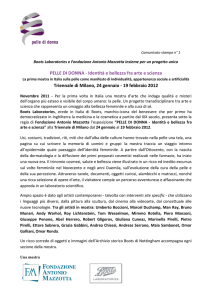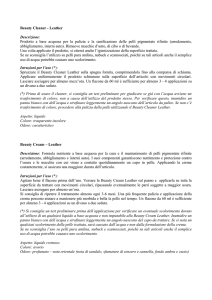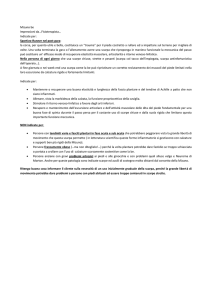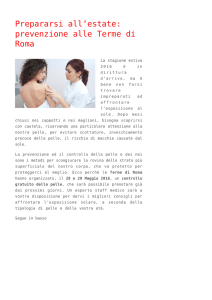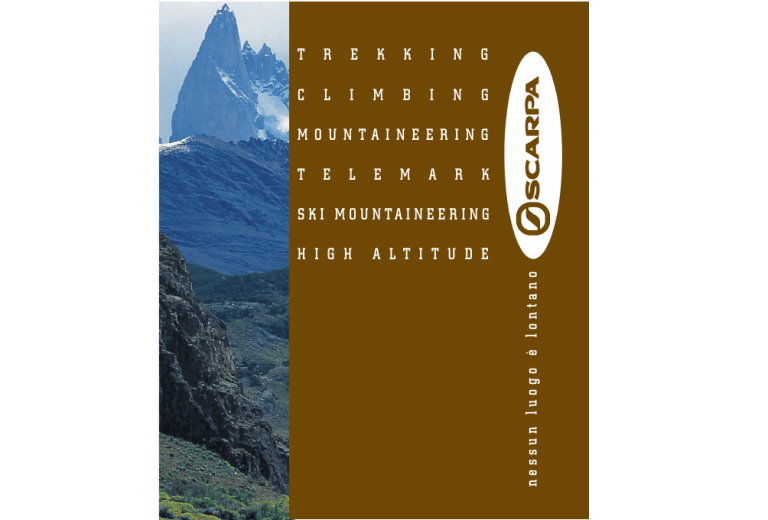
T
R
E
K
K
I
N
G
C
L
I
M
B
I
N
G
M O U N TA I N E E R I N G
T
E
L
E
M
A
R
K
S K I M O U N TA I N E E R I N G
A L T I T U D E
nessun luogo è lontano
H I G H
WHICH BOOT?
L’ETICHETTA POSTA SULLA SCATOLA SPIEGA LE
CARATTERISTICHE DELLE CALZATURE.
FATE RIFERIMENTO A QUESTA ETICHETTA PER
LE INFORMAZIONI RIGUARDANTI LA MANUTENZIONE DELLE VOSTRE CALZATURE.
ULTERIORI INFORMAZIONI SONO DISPONIBILI
SUL NOSTRO SITO INTERNET.
THE BOOT BOX LABEL SHOWS YOU THE
DETAILS OF YOUR BOOTS. PLEASE REFER TO
THIS FOR DETAILS ON BOOT CARE. FURTHER
INFORMATION IS ALSO AVAILABLE ON OUR
WEBSITE (SEE REAR COVER).
NOME
BOOT NAME
ARTICOLO
ARTICLE NO.
TIPO PELLAME
TYPE OF UPPER
88001
ROVESCIATO
SUOLA
SOLE
FORMA
LAST
DL
41004
B3
COLORE
COLOUR
LIMONE
M4 TECH
41
1758
TAGLIA
SIZE
MANUTENZIONE
DEGLI SCARPONI
sul lato anteriore della
scatola oppure leggete
questo catalogo prodotto.
Complimenti per aver
acquistato un paio di scarponi Scarpa.
Da oltre 50 anni l'azienda
Scarpa produce scarponi
di alta qualità da montagna e da trekking ed è
considerata probabilmente
la migliore azienda artigianale al mondo in questo campo.
Ora che avete fatto il
vostro acquisto, le seguenti informazioni dovrebbero aiutarvi ad ottenere il
meglio dai vostri scarponi
e consigliarvi sul modo
migliore per prendervene
cura. Per determinare di
quale pelle o materiale
sono fatti i vostri scarponi,
consultate l'etichetta posta
La pelle è un materiale
naturale, e la scelta della
giusta varietà a seconda
dell'utilizzo finale dello
scarpone è competenza
essenziale e altamente
specialistica. La provenienza del cuoio, la sua
età, l'allevamento e la cura
dell'animale, la concia,
sono tutti fattori determinanti per le prestazioni
finali e l'aspetto esteriore
dello scarpone. SCARPA
ha un'esperienza di oltre
50 anni nel trattare diretta-
LA PELLE
mente con le concerie per
assicurarsi le pelli migliori
e nel selezionare il cuoio
da utilizzare nei propri
scarponi da camminata e
da montagna. In particolare, la concia è un elemento
determinante nella produzione di pelli di qualità ed
è poi quel procedimento
che rende la pelle resistente all'acqua. Alcune pelli
vengono sottoposte a concia tradizionale con l'uso
di composti classici, mentre quelle più costose,
come le HS12 di Scarpa,
attraversano un trattamento che prevede l'inserimento in profondità di un
composto a base di silicone. Questo garantisce alla
pelle una migliore e più
durevole resistenza all'acqua e le consente di asciugarsi più velocemente
anche quando è impregnata. La pelle è tuttora ritenuta il materiale migliore
per gli scarponi da camminata di qualità, tuttavia
essa richiede una certa
manutezione e protezione
per preservarne le prestazioni.
SCARPONI
IMPERMEABILI O
RESISTENTI
ALL’ACQUA?
Anzitutto occorre chiarire
un equivoco molto diffuso: nessuno scarpone in
pelle è impermeabile, e
sono lo stesso procedimento costruttivo e la
stessa natura della pelle a
non consentirlo. Per rendere uno scarpone impermeabile occorre inserire
un'imbottitura impermeabile, ma la presenza di tale
inserto crea spesso un
compromesso di costi supplementari e dunque lo
svantaggio di sminuire
l'impermeabilità. E' tuttavia possibile migliorare la
resistenza all'acqua della
pelle dei vostri scarponi
osservando i seguenti suggerimenti per la manutenzione.
CONSIGLI PER LA
MANUTENZIONE
Il primo passo nella manutezione regolare è quello
di pulire gli scarponi,
spazzolando via dalla
tomaia fango e sporcizia.
Qualora essi fossero particolarmente sporchi, occorre strofinarli leggermente
con una spazzola di nylon
e acqua calda. Lasciare
quindi asciugare a temperatura ambiente in una
stanza ben arieggiata. Non
esporre gli scarponi a
fonti di calore di qualsiasi genere perché questo
danneggerebbe la pelle. I
trattamenti di rivitalizzazione e di impermeabilizzazione sono essenziali
perché, durante l'uso (e in
particolare in condizioni
di umidità), si verifica
sulla pelle una perdita progressiva dei prodotti della
conciatura. Se non vengono effettuati tali trattamenti, si produrrà una perdita
di resistenza all'acqua,
seguita da un irrigidimento graduale della pelle,
con conseguente possibile
crepatura: a quel punto la
pelle è irrimediabilmente
danneggiata. Per evitare
questo, è importante che
gli scarponi siano trattati
per preservare l'idrorepellenza e nutrire la pelle con
prodotti lubrificanti e rigeneranti. Di seguito riportiamo delle brevi descrizioni dei principali tipi di
pelli utilizzate per gli scarponi SCARPA e dei modi
migliori per effettuarne la
manutenzione.
PELLAME PLATA
Pelle di alta qualità, spessore da 2,4 a 2,6 mm,
ideale per scarponi leggeri
da trekking anche su terreni rocciosi, che richiedono
meno rodaggio. Utilizzare
un prodotto impermeabilizzante sul nuovo: per
risultati eccellenti consigliamo la crema Scarpa
HS12, il Nabuck o il GWax, oppure una cera a
base di acqua come l'Aqueous Nikwax.
SHERPA HS12
Pelle conciata di spessore
da 2,7 a 2,9 mm: l'eccezionale spessore e la resistenza di questa pelle la
rendono perfetta per scarponi da montagna e da
trekking più severo, dove
sono importanti un mag-
gior supporto e una maggiore resistenza all'usura.
La Sherpa viene trattata
con la conciatura HS12,
che la rende durevole e
resistente all'usura e le
impedisce di impregnarsi
facilmente d'acqua.
Raccomandiamo l'uso sul
nuovo della crema HS12
Scarpa, espressamente
formulata per preservare
le prestazioni della pelle
HS12. In alternativa, è
possibile utilizzare l'Aqueous Nikwax (da applicare preferibilmente quando gli scarponi sono
bagnati). Occorre sempre
tener presente che i trattamenti non saranno assorbiti immediatamente dalla
pelle HS12 a causa dell'alto contenuto di silicone
trattenuto sulla superficie
della pelle durante il pro-
cedimento di conciatura
HS12. Col tempo inizieranno comunque ad essere
assorbiti mano a mano che
lo scarpone si consumerà
normalmente con l'uso.
NABUCK HS12
Il Nabuck è una pelle
pieno fiore la cui superficie esterna presenta una
finitura finemente sabbiata, che conferisce allo
scarpone un ulteriore
fascino. Il Nabuck è un
tipo di pelle di ottima qualità e non deve essere confusa con la crosta. Raccomandiamo in questo caso
l'uso di trattamenti speciali per Nabuck sul nuovo.
Possono essere applicati
trattamenti più convenzionali (come ad es. il
Nikwax), sebbene tendano
a rendere liscia la finitura
rugosa tipica di questa
pelle.
ANFIBIO
ROVESCIATO
Si tratta di pelle di prima
qualità utilizzata per scarponi da alpinismo puri
dove sono richiesti la massima forza e resistenza
all'abrasione e il massimo
supporto. Questi tipi di
pelle vengono utilizzati
con la parte conciata verso
l'esterno, oppure sono
rovesciati con la parte
rugosa verso l'esterno e la
parte conciata verso l'interno. Tutte le pelli Anfibio
SCARPA sono trattate con
l'HS12 : per quelle con la
superficie conciata verso
l'esterno dello scarpone
raccomandiamo un trattamento con la crema HS12,
il Nikwax, l'Aqueous
Nikwax o il G-Wax, mentre per quelle rovesciate
raccomandiamo il Nikwax
Fabric & Leather, seguito
da una leggera spazzolata
con una spazzola per scamosciati. In alternativa,
per ottenere la massima
resistenza all'acqua, utilizzare l'Aqueous Nikwax.
CORDURA/CROSTA
Questi scarponi sono fatti
con materiali più economici rispetto alla pelle
pieno fiore, e generalmen-
te non offrono le prestazioni di resistenza all'acqua o di durata di una
pelle di qualità. Ciò nonostante richiedono una
manutenzione regolare e
per questo consigliamo
l'utilizzo di prodotti per la
Crosta come il Nikwax
Nubuck & Leather o il
Graingers G-Sport.
FODERE INTERNE
La maggior parte degli
scarponi Scarpa hanno
fodere o di pelle o di
Cambrelle. Il Cambrelle
presenta alcuni vantaggi
in quanto non richiede
manutenzione, assorbe il
sudore del piede, si asciu-
ga in fretta ed ha una
lunga durata. Al contrario,
le fodere di pelle, se da
una parte sono più costose, dall'altra sono di ottima qualità e offrono un
comfort migliore, oltre
che un migliore adattamento della forma alla
scarpetta interna. E'
importante però effettuare
una manutenzione costante di queste ultime, al fine
di prevenire la disidratazione e la conseguente
crepatura della pelle : questo può succedere usando
gli scarponi in condizioni
di umidità (e in particolare
in condizioni di acqua
acida), ma può anche
essere causato dal danno
permanente dato dal sudore del piede. Per prevenire
questi danni, raccomandiamo di lavare periodica-
mente le fodere in pelle e
di trattarle con l'apposito
detergente e rigenerante
Nikwax. Inoltre è possibile di tanto in tanto dare
una leggera reimpermeabilizzazione facoltativa
alle imbottiture mediante
la Crema Scarpa HS12.
Scegliete attentamente la
forma ed il numero della
calzatura, in modo che il
piede sia ben fasciato e
bloccato. Questo accorgimento non permetterà al
piede di muoversi e saranno
quindi eliminate le problematiche di usura della fodera interna, sia essa in pelle,
Cambrelle®, o Gore-Tex®.
ACCESSORI E
MANUTENZIONE
Le prestazioni dei vostri
scarponi sono anche determinate dalle prestazioni
del sottopiede interno.
Tutti i sottopiedi Scarpa
presentano la componente
di carboni attivi che riduce
al minimo gli odori, e sono
inoltre imbottiti, foderati e
conformati per adattarsi
agli scarponi Scarpa. Tuttavia, col passare del tempo,
essi sono soggetti a deterioramento.
Consigliamo di controllare
periodicamente il sottopiede e, qualora presentasse
segni di usura o cedimenti,
di sostituirlo. La Scarpa
offre una serie di sottopiedi
di riserva che potete richiedere al Vostro rivenditore.
Gli scarponi Scarpa sono
concepiti per durare molti
anni.
Tuttavia, anche le suole di
gomma si usurano col
tempo. Raccomandiamo
pertanto di non indossare
scarponi con suole molto
usurate (la maggior parte
degli incidenti in montagna
o in collina sono causati da
scivolamenti).
CONSIGLI
GENERALI PER LA
MANUTENZIONE
E' consigliabile applicare
trattamenti ai passanti e ai
ganci delle linguette, ma
occorre non esagerare, in
quanto essi possono
ammorbidire troppo o
anche danneggiare la pelle
e le cuciture. Raccomandiamo vivamente di
impermeabilizzare gli
scarponi appena acquistati
in quanto questo aiuterà a
preservare gli olii naturali
e i trattamenti applicati
sulla pelle durante la concia. La Crema Scarpa
HS12, il Nikwax Nabuck
e il Nikwax Fabric &
Leather sono speciali trattamenti di alta qualità per
la pelle, il cui uso sugli
scarponi Scarpa è autorizzato da quest'ultima, e
sono disponibili presso
rivenditori specializzati di
calzature outdoor. Esistono oggigiorno sul mercato
tanti prodotti per la pelle
che siamo spiacenti di non
poter raccomandare l'uso
di trattamenti non espressamente approvati.
TAKING CARE
OF YOUR BOOTS
end of the boot box or
refer to the current product catalogue.
Congratulations on having
bought a pair of Scarpa
boots. Scarpa has been
making high quality
mountain and hill boots
for over 50 years and are
regarded by many as probably the worlds finest
craftsmen of quality
mountain boots.
Having made your purchase we, hope the following information will
help you get the best out
of your boots and advise
you of the best way to
look after them. To identify which leather or material your boots are made
from you can either look
on the label on the front
Leather is a natural material and selection of the
right grade of leather to
meet the end use of the
boot is an essential and
highly specialist skill. The
origin of the hide, the age,
rearing and care of the
beast and the tanning process are all critical elements which effect the
finished performance and
look of the boot. SCARPA
have over 50 years experience of dealing and
LEATHER
negotiating with tanneries
to secure the finest
leathers and meticulously
select the hides they use in
their leather walking and
mountain boots. The tanning process is a critical
factor in the production of
quality leathers and is
what makes the leather
water resistant. Some
leathers use traditional
tanning processes and
ingredients. More expensive leathers like Scarpa’s
HS12 use a tanning treatment which forces a silicone based ingredient
deep into the leather. This
gives an improved and
more durable water resistance to the leather and
also allows the leather to
dry out faster even when it
does become wet. Leather
is still regarded as the
finest material for quality
walking boots. It does
however require care and
protection to maintain its
performance.
a waterproof liner but with
any waterproof insert
there is often a trade off of
extra cost and some disadvantage to offset the extra
waterproofness. However
you can improve the water
resistance of your leather
by observing the following care recommendations.
ARE MY LEATHER
BOOTS
WATERPROOF?
There are many misconceptions about this. What
you should know is that
no leather boots are waterproof. The very construction process and the nature
of leather determines that
they cannot be waterproof.
To make a boot waterproof requires the insert of
CARE OF YOUR
BOOTS
The first step in a regular
maintenance programme
is to clean your boots.
Brush off dirt or mud from
the uppers. If your boots
are particulary dirty scrub
them lightly with warm
water and a nylon brush. It
is also advisable to periodically clean the lining
with warm water. Dry
your boots slowly in a
room with good air circulation and at normal room
temperature. Do not
subject your boots to any
form of heat source to
dry them as this will
damage the leather.
Waterproofing and conditioning is essential as
during use (and especially
in wet conditions), there is
a progressive loss of the
tanning ingredients from
the leather. If left untreated, this will result in a
loss of water resistance
followed by gradual stiffening
and
eventual
cracking of the leather, at
which point the leather is
irreversibly damaged. To
avoid this it is important
that the boots are treated
to maintain their water
repellancy and to feed the
leather with renewed tanning and lubricating ingredients. The following is a
description of the main
leathers used in SCARPA
boot manufacturing and
how best to care for them.
boots, which require less
breaking-in. Use a proofing agent from new, for
best results we recommend using Scarpa HS12
Cream, Nikwax or G-Wax
or alternatively a water
based wax treatment such
as Aqueous Nikwax.
HS12 SHERPA
LEATHER
PLATA CALF
LEATHER
High quality leather of 2.4
mm to 2.6 mm in thickness, they are ideal for fell
or lightweight hillwalking
A 2.7 mm to 2.9 mm tanned leather. The extra
thickness and durability of
this leather is perfectly
suited to stronger hill and
mountain walking boots,
where extra support is
important.
Sherpa leather is treated
with the HS12 tanning
process which is durable
and resistant to scuffing
and stops the leather from
wetting out so easily.
We recommend the use
from new of Scarpa’s
HS12 Cream, which is
specially formulated to
maintain the performance
of HS12 leather. Alternatively you can use Aqueous
Nikwax (which is best
applied when the boots are
wet).
Please note that treatments
will not soak in to HS12
leathers immediately due
to the high silicone retained on the surface of the
leather during the HS12
tanning process. It will
however begin to soak in
over time as the boots
become scuffed with use.
HS12 NUBUCK
LEATHER
Nubuck is a full grain
leather where the outer
surface of the leather has a
finely sanded, texturised
finish which gives the
boot an added appeal.
Nubuck is a full quality
leather and should not be
confused with suede. We
recommend the use of
specialised
Nubuck
leather tretments from
new. Conventional treatments (e.g. Nikwax) can
be used however this will
make smooth the texturised
finish of the leather.
RESERVED
(ROVESCIATO)
LEATHER-CROSTA
These are premier leathers
used on full mountainnering boots where maximum strength, support and
abrasion resistance is
required. These leathers
are used with either the
tanned finish out or are
reversed with the textured
side out and the tanned
surface inside. All SCARPA Anfibio leathers are
HS12 treated. For Anfibio
Leathers with the tanned
surface on the outside of
the boot we recommend
treating this with HS12
Cream, Nikwax, Aqueous
Nikwax or G. Wax. For
reversed Anfibio leather
and Crosta leather we
recommend Nikwax Fabric
& Leather treatment, followed by a light brushing
with a suede brush. This
will retain the appearance
of the reversed leather.
Alternatively for maximun
water resistance use
Aqueous Nikwax.
from cheaper priced materials than full grain
leathers. Generally, they
will not offer the performance water resistance or
durability of a quality
leather. They do require
regular care and we
recommend
use
of
Nubuck and Suede treatment such as Nikwax
Nubuck & Suede or
Graingers G-Sport.
BOOT LINING
CORDURA/SUEDE
These boots are made
Most Scarpa boots are
lined with either leather or
Cambrelle linings. Cambrelle has certain advantages in that, it requires no
maintenance, absorbs foot
moisture, is quick drying
and very durable. However
leather linings, whilst being
more expensive, are superb
quality and allow better
comfort and shaping
around the boot inner.
However, it is important
that leather linings are
looked after to avoid the
leather drying out and
cracking. This can often be
caused by using boots in
wet conditions (particularly
in acidic water situations).
It can also be caused by the
prolonged damage caused
by foot sweat. To avoid this
damage we recommend
that you should periodically wash out the leather
linings and treat them with
Nikwax leather cleaner and
conditioner. Additionally, it
is also possible to occasionally, lightly reproof linings
with Scarpa HS12 Cream if
desired.
ACCESSORIES AND
MAINTENANCE
The performance of your
boots is also influenced by
the performance of the
internal footbed. Scarpa
footbeds all feature a carbon active constituent to
minimise foot odour and
are padded, lined and shaped to suit Scarpa boots.
However footbeds will
deteriorate over time. We
recommend that you
should periodically check
the internal footbed and if
it shows signs of wear or
losing its support then you
should replace it. Scarpa
have a range of replacement footbeds which your
local stockist can supply.
Scarpa boots are made to
give many years of use.
However rubber soles will
wear over time. We
recommend that you do
not wear boots with badly
worn soles (most accidents in the mountains and
hills are caused through
people slipping).
GENERAL BOOTS
CARE ADVICE
Take care to apply treatments to tongues D. rings
and hooks but do not over
treat boots with treatments
as this can soften and
damage the leather and
stitching. We strongly
recommend that all boots
should be proofed from
new as this will help preserve the natural tanning
oils and treatments in the
leather. Scarpa HS12
Cream, Nikwax and GWax are high quality, specialist leather treatments
that are approved for use
with Scarpa boots and are
available from specialist
outdoor footwear retailers.
There are now so many
leather treatments on the
market of varying qualities that we regret we cannot recommend the use of
treatments that we have
not approved.
Te l . 0 4 2 3 / 5 2 8 4 r. a .
Fax 0423/528599
PRINTED IN DECEMBER 2006
Viale Tiziano, 26 31010 Asolo TV
www.scarpa.net - E-mail [email protected]
Calzaturificio
S . C . A . R . P. A . s p a
nessun luogo è lontano
B&B TESI ASOLO
B&B TESI ASOLO
T
R
E
K
K
I
N
G
C
L
I
M
B
I
N
G
M O U N TA I N E E R I N G
T
E
L
E
M
A
R
K
H I G H
A L T I T U D E
nessun luogo è lontano
nessun luogo è lontano
S K I M O U N TA I N E E R I N G

